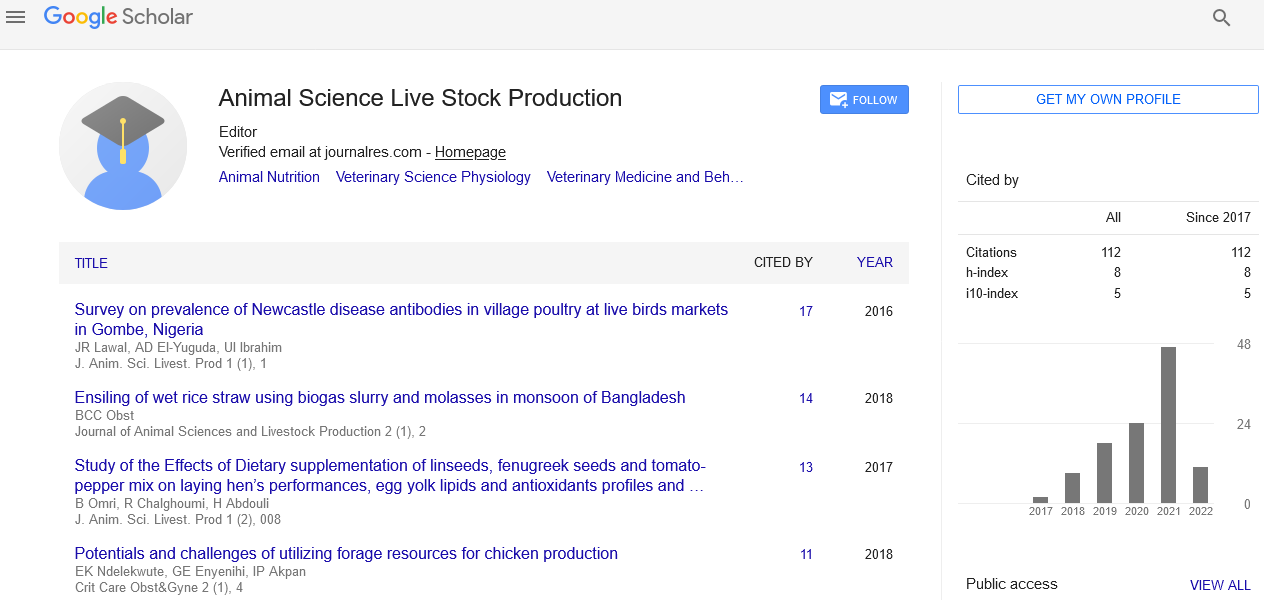Commentary - (2024) Volume 8, Issue 4
Livestock Production: A Pillar of Global Agriculture
Wei Jiang*
Department of Animal Sciences, Peking University, China
*Correspondence:
Wei Jiang,
Department of Animal Sciences, Peking University,
China,
Email:
Received: 02-Dec-2024, Manuscript No. IPJASLP-24-22165;
Editor assigned: 04-Dec-2024, Pre QC No. IPJASLP-24-22165 (PQ);
Reviewed: 18-Dec-2024, QC No. IPJASLP-24-22165;
Revised: 23-Dec-2024, Manuscript No. IPJASLP-24-22165 (R);
Published:
30-Dec-2024, DOI: 10.36648/2577-0594.8.4.35
Description
Livestock production has been a cornerstone of agriculture for
millennia, playing a vital role in feeding the world, supporting
economies, and providing materials for various industries.
From cattle and sheep to poultry and goats, livestock offers
a wide array of products such as meat, milk, eggs, wool, and
leather, all of which are essential for human survival and
economic growth. However, the challenges and opportunities
of modern livestock production are complex and require
sustainable practices to meet the demands of a growing global
population. Livestock production contributes significantly
to global food security. Animal products such as meat, milk,
and eggs are rich sources of protein, vitamins, and essential
nutrients. Smallholder farmers rely on their animals for food,
income, and social capital, as livestock can be sold or traded
for other goods. For example, goats, chickens, and cows are
often used as a source of cash or a form of savings in rural
communities. Livestock production, therefore, is not only an
agricultural activity but a key economic pillar in many regions.
The global livestock sector is incredibly diverse, with different
species raised for various purposes. Raised primarily for meat
(beef) and milk, cattle are one of the most important sources
of protein worldwide. Beef and dairy farming is central to the
economy in countries like the United States, Brazil, and India.
Chicken and other poultry species are raised for meat and
eggs. Poultry farming is a rapidly growing sector due to the
relatively low costs of raising chickens and the high demand
for affordable protein. Livestock ownership can be a way to
accumulate wealth, with cattle, sheep, and goats representing
assets that can be sold in times of need. Livestock also support
industries like leather, pharmaceuticals, and cosmetics, where
by-products like hides and collagen are processed for use. While
livestock production has undeniable economic and nutritional
benefits, it also faces growing scrutiny due to its environmental
and ethical implications. Large-scale livestock farming,
especially cattle ranching, has been linked to deforestation,
greenhouse gas emissions, and soil degradation. The FAO
estimates that livestock farming accounts for around 14.5%
of global greenhouse gas emissions, mainly due to methane
produced by ruminants like cows and sheep. Moreover, animal
welfare concerns have led to calls for more humane practices
in livestock farming. The use of factory farming techniques,
where animals are kept in cramped, unsanitary conditions,
has raised ethical questions about the treatment of animals.
To address these challenges, there is a growing focus on
sustainable livestock farming practices. These include improved
feed efficiency, rotational grazing, waste management, and
the development of alternative proteins, such as plant-based
meat substitutes and lab-grown meat, which could reduce the
environmental footprint of traditional livestock production.
As the global population continues to grow, the demand for
animal products is expected to increase. However, the need
for sustainable practices is more urgent than ever. Advances in
technology, better management practices, and a shift toward
more ethical farming can help ensure that livestock production
remains a vital resource for the future. In conclusion, livestock
production is a fundamental aspect of global agriculture
that contributes to food security, economic development,
and cultural traditions. However, its sustainability depends
on innovation and responsibility to mitigate environmental
impacts and improve animal welfare. With the right balance,
livestock can continue to play a crucial role in feeding the world
while minimizing its ecological footprint.
Acknowledgement
None.
Conflict Of Interest
None.
Citation: Jiang W (2024) Livestock Production: A Pillar of Global Agriculture. J Animal Sci. 8:35.
Copyright: © 2024 Jiang W. This is an open-access article distributed under the terms of the Creative Commons Attribution License, which permits unrestricted use, distribution, and reproduction in any medium, provided the original author and source are credited.

